ECU Hyundai Elantra 2015 Owner's Manual - RHD (UK. Australia)
[x] Cancel search | Manufacturer: HYUNDAI, Model Year: 2015, Model line: Elantra, Model: Hyundai Elantra 2015Pages: 498, PDF Size: 9.45 MB
Page 10 of 498
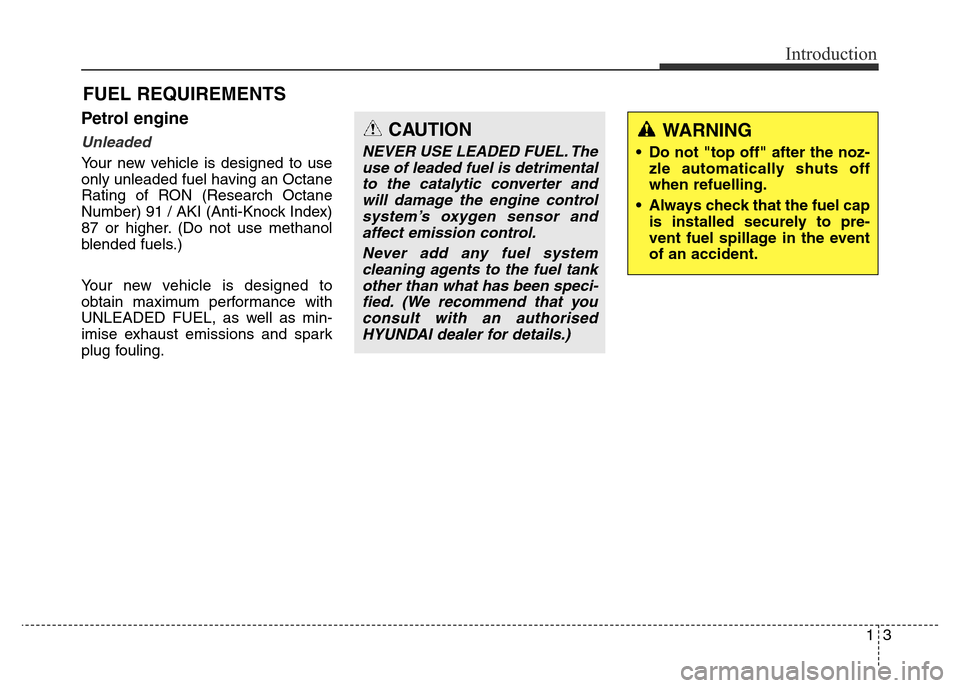
13
Introduction
Petrol engine
Unleaded
Your new vehicle is designed to use
only unleaded fuel having an Octane
Rating of RON (Research Octane
Number) 91 / AKI (Anti-Knock Index)
87 or higher. (Do not use methanol
blended fuels.)
Your new vehicle is designed to
obtain maximum performance with
UNLEADED FUEL, as well as min-
imise exhaust emissions and spark
plug fouling.
FUEL REQUIREMENTS
CAUTION
NEVER USE LEADED FUEL. The
use of leaded fuel is detrimental
to the catalytic converter and
will damage the engine control
system’s oxygen sensor and
affect emission control.
Never add any fuel system
cleaning agents to the fuel tank
other than what has been speci-
fied. (We recommend that you
consult with an authorised
HYUNDAI dealer for details.)
WARNING
• Do not "top off" after the noz-
zle automatically shuts off
when refuelling.
• Always check that the fuel cap
is installed securely to pre-
vent fuel spillage in the event
of an accident.
Page 22 of 498
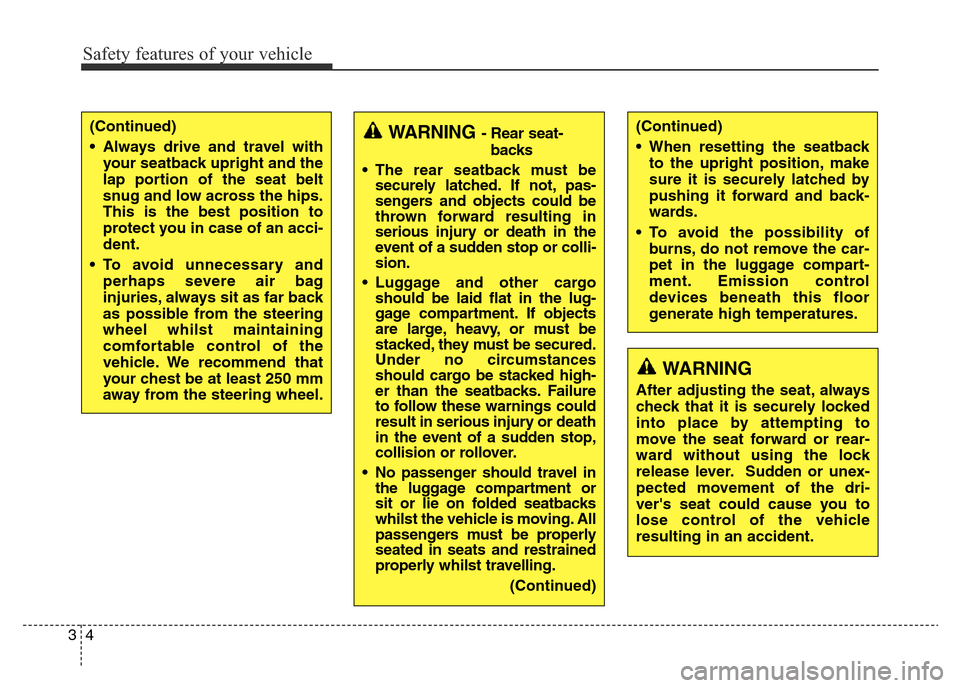
Safety features of your vehicle
4 3
(Continued)
• Always drive and travel with
your seatback upright and the
lap portion of the seat belt
snug and low across the hips.
This is the best position to
protect you in case of an acci-
dent.
• To avoid unnecessary and
perhaps severe air bag
injuries, always sit as far back
as possible from the steering
wheel whilst maintaining
comfortable control of the
vehicle. We recommend that
your chest be at least 250 mm
away from the steering wheel.WARNING- Rear seat-
backs
• The rear seatback must be
securely latched. If not, pas-
sengers and objects could be
thrown forward resulting in
serious injury or death in the
event of a sudden stop or colli-
sion.
• Luggage and other cargo
should be laid flat in the lug-
gage compartment. If objects
are large, heavy, or must be
stacked, they must be secured.
Under no circumstances
should cargo be stacked high-
er than the seatbacks. Failure
to follow these warnings could
result in serious injury or death
in the event of a sudden stop,
collision or rollover.
• No passenger should travel in
the luggage compartment or
sit or lie on folded seatbacks
whilst the vehicle is moving. All
passengers must be properly
seated in seats and restrained
properly whilst travelling.
(Continued)(Continued)
• When resetting the seatback
to the upright position, make
sure it is securely latched by
pushing it forward and back-
wards.
• To avoid the possibility of
burns, do not remove the car-
pet in the luggage compart-
ment. Emission control
devices beneath this floor
generate high temperatures.
WARNING
After adjusting the seat, always
check that it is securely locked
into place by attempting to
move the seat forward or rear-
ward without using the lock
release lever. Sudden or unex-
pected movement of the dri-
ver's seat could cause you to
lose control of the vehicle
resulting in an accident.
Page 23 of 498
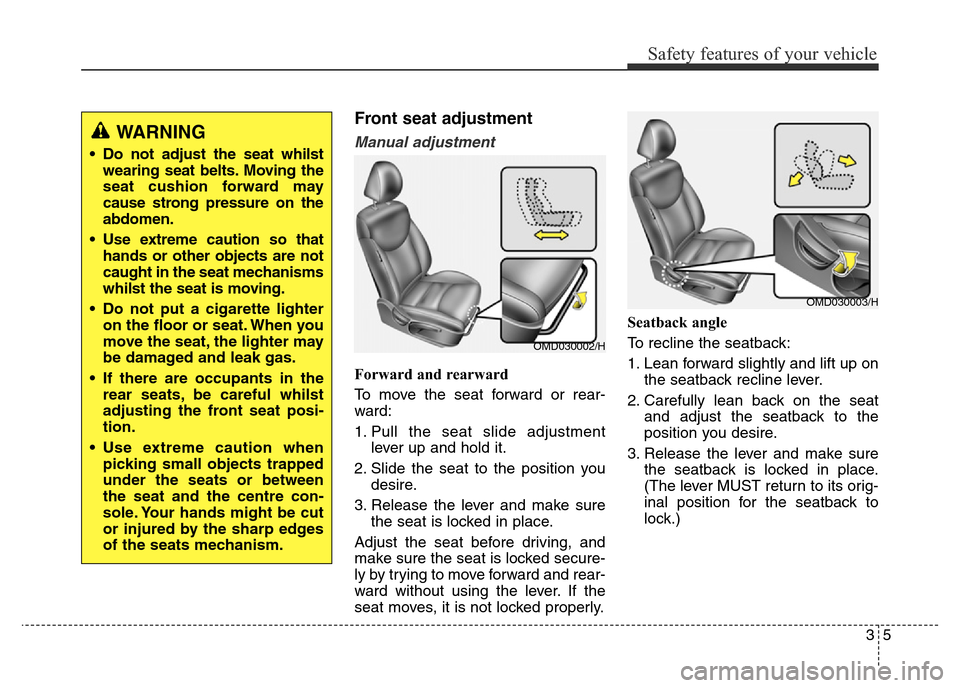
35
Safety features of your vehicle
Front seat adjustment
Manual adjustment
Forward and rearward
To move the seat forward or rear-
ward:
1. Pull the seat slide adjustment
lever up and hold it.
2. Slide the seat to the position you
desire.
3. Release the lever and make sure
the seat is locked in place.
Adjust the seat before driving, and
make sure the seat is locked secure-
ly by trying to move forward and rear-
ward without using the lever. If the
seat moves, it is not locked properly.Seatback angle
To recline the seatback:
1. Lean forward slightly and lift up on
the seatback recline lever.
2. Carefully lean back on the seat
and adjust the seatback to the
position you desire.
3. Release the lever and make sure
the seatback is locked in place.
(The lever MUST return to its orig-
inal position for the seatback to
lock.)
WARNING
• Do not adjust the seat whilst
wearing seat belts. Moving the
seat cushion forward may
cause strong pressure on the
abdomen.
• Use extreme caution so that
hands or other objects are not
caught in the seat mechanisms
whilst the seat is moving.
• Do not put a cigarette lighter
on the floor or seat. When you
move the seat, the lighter may
be damaged and leak gas.
• If there are occupants in the
rear seats, be careful whilst
adjusting the front seat posi-
tion.
• Use extreme caution when
picking small objects trapped
under the seats or between
the seat and the centre con-
sole. Your hands might be cut
or injured by the sharp edges
of the seats mechanism.
OMD030002/H
OMD030003/H
Page 35 of 498
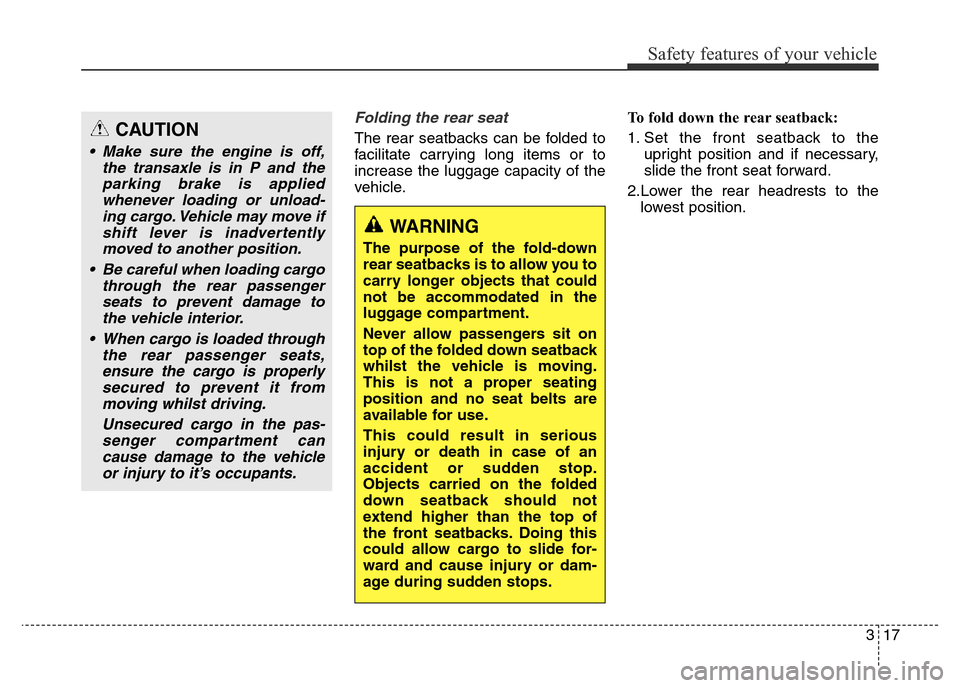
317
Safety features of your vehicle
Folding the rear seat
The rear seatbacks can be folded to
facilitate carrying long items or to
increase the luggage capacity of the
vehicle.To fold down the rear seatback:
1. Set the front seatback to the
upright position and if necessary,
slide the front seat forward.
2.Lower the rear headrests to the
lowest position.CAUTION
• Make sure the engine is off,
the transaxle is in P and the
parking brake is applied
whenever loading or unload-
ing cargo. Vehicle may move if
shift lever is inadvertently
moved to another position.
• Be careful when loading cargo
through the rear passenger
seats to prevent damage to
the vehicle interior.
• When cargo is loaded through
the rear passenger seats,
ensure the cargo is properly
secured to prevent it from
moving whilst driving.
Unsecured cargo in the pas-
senger compartment can
cause damage to the vehicle
or injury to it’s occupants.
WARNING
The purpose of the fold-down
rear seatbacks is to allow you to
carry longer objects that could
not be accommodated in the
luggage compartment.
Never allow passengers sit on
top of the folded down seatback
whilst the vehicle is moving.
This is not a proper seating
position and no seat belts are
available for use.
This could result in serious
injury or death in case of an
accident or sudden stop.
Objects carried on the folded
down seatback should not
extend higher than the top of
the front seatbacks. Doing this
could allow cargo to slide for-
ward and cause injury or dam-
age during sudden stops.
Page 37 of 498
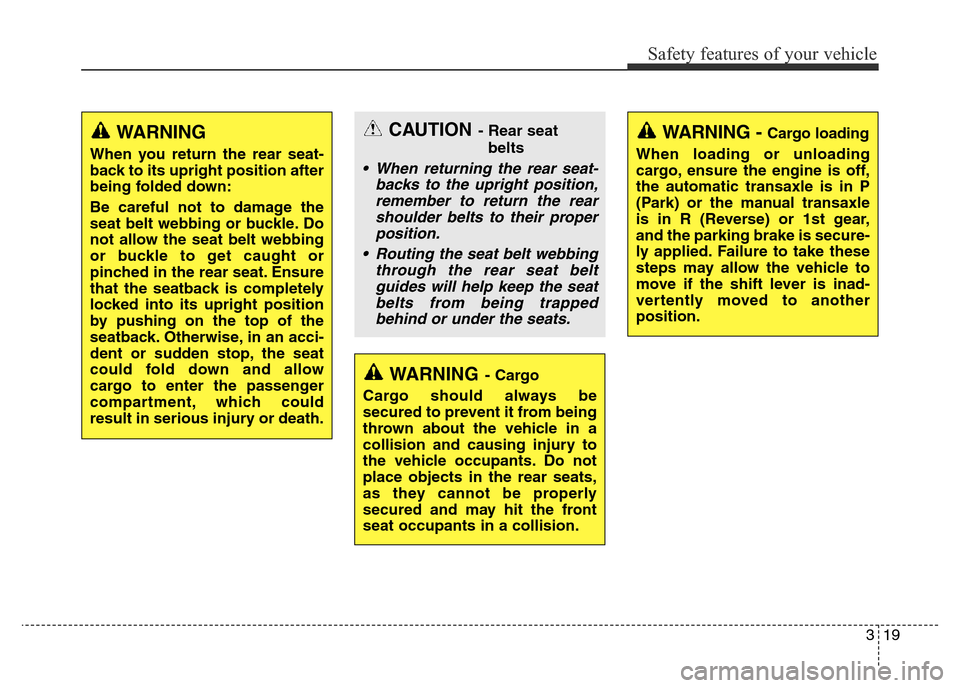
319
Safety features of your vehicle
WARNING- Cargo
Cargo should always be
secured to prevent it from being
thrown about the vehicle in a
collision and causing injury to
the vehicle occupants. Do not
place objects in the rear seats,
as they cannot be properly
secured and may hit the front
seat occupants in a collision.
WARNING - Cargo loading
When loading or unloading
cargo, ensure the engine is off,
the automatic transaxle is in P
(Park) or the manual transaxle
is in R (Reverse) or 1st gear,
and the parking brake is secure-
ly applied. Failure to take these
steps may allow the vehicle to
move if the shift lever is inad-
vertently moved to another
position.WARNING
When you return the rear seat-
back to its upright position after
being folded down:
Be careful not to damage the
seat belt webbing or buckle. Do
not allow the seat belt webbing
or buckle to get caught or
pinched in the rear seat. Ensure
that the seatback is completely
locked into its upright position
by pushing on the top of the
seatback. Otherwise, in an acci-
dent or sudden stop, the seat
could fold down and allow
cargo to enter the passenger
compartment, which could
result in serious injury or death.
CAUTION- Rear seat
belts
• When returning the rear seat-
backs to the upright position,
remember to return the rear
shoulder belts to their proper
position.
• Routing the seat belt webbing
through the rear seat belt
guides will help keep the seat
belts from being trapped
behind or under the seats.
Page 39 of 498
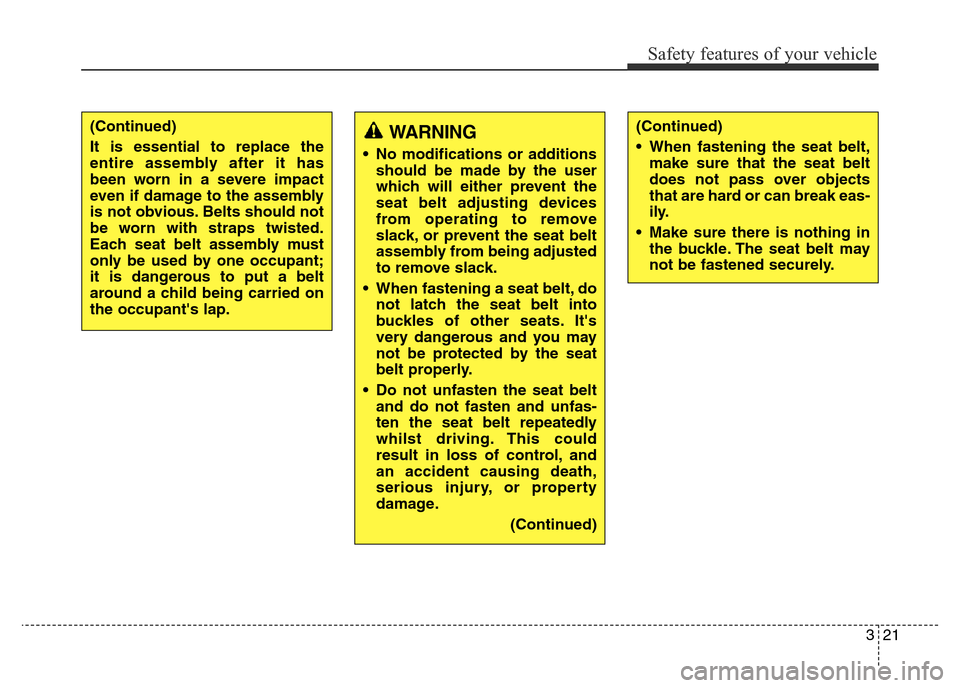
321
Safety features of your vehicle
WARNING
• No modifications or additions
should be made by the user
which will either prevent the
seat belt adjusting devices
from operating to remove
slack, or prevent the seat belt
assembly from being adjusted
to remove slack.
• When fastening a seat belt, do
not latch the seat belt into
buckles of other seats. It's
very dangerous and you may
not be protected by the seat
belt properly.
• Do not unfasten the seat belt
and do not fasten and unfas-
ten the seat belt repeatedly
whilst driving. This could
result in loss of control, and
an accident causing death,
serious injury, or property
damage.
(Continued)
(Continued)
• When fastening the seat belt,
make sure that the seat belt
does not pass over objects
that are hard or can break eas-
ily.
• Make sure there is nothing in
the buckle. The seat belt may
not be fastened securely.(Continued)
It is essential to replace the
entire assembly after it has
been worn in a severe impact
even if damage to the assembly
is not obvious. Belts should not
be worn with straps twisted.
Each seat belt assembly must
only be used by one occupant;
it is dangerous to put a belt
around a child being carried on
the occupant's lap.
Page 47 of 498
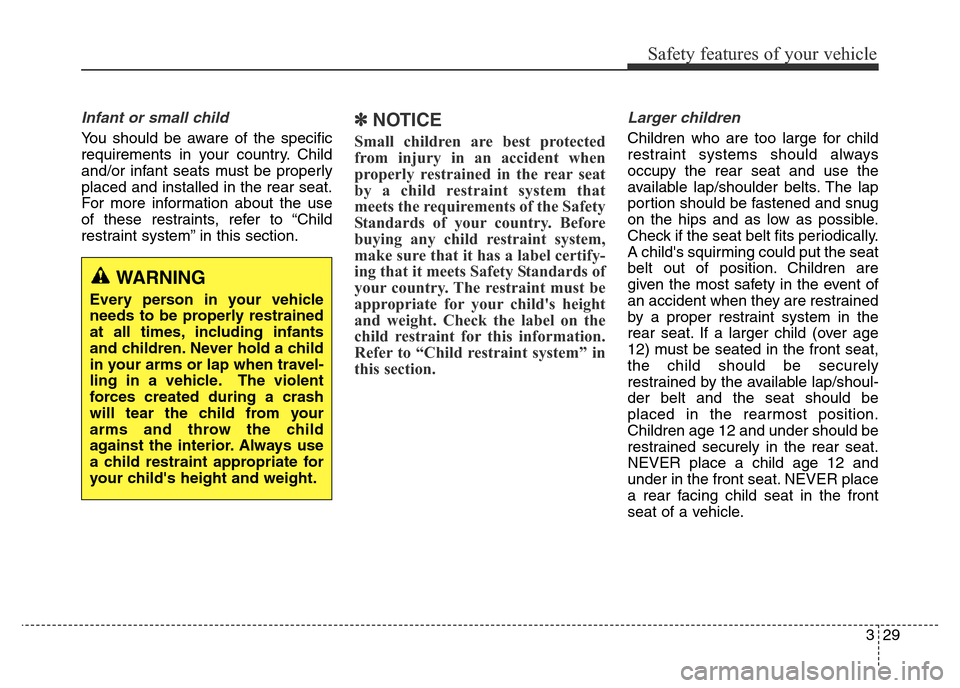
329
Safety features of your vehicle
Infant or small child
You should be aware of the specific
requirements in your country. Child
and/or infant seats must be properly
placed and installed in the rear seat.
For more information about the use
of these restraints, refer to “Child
restraint system” in this section.
✽NOTICE
Small children are best protected
from injury in an accident when
properly restrained in the rear seat
by a child restraint system that
meets the requirements of the Safety
Standards of your country. Before
buying any child restraint system,
make sure that it has a label certify-
ing that it meets Safety Standards of
your country. The restraint must be
appropriate for your child's height
and weight. Check the label on the
child restraint for this information.
Refer to “Child restraint system” in
this section.
Larger children
Children who are too large for child
restraint systems should always
occupy the rear seat and use the
available lap/shoulder belts. The lap
portion should be fastened and snug
on the hips and as low as possible.
Check if the seat belt fits periodically.
A child's squirming could put the seat
belt out of position. Children are
given the most safety in the event of
an accident when they are restrained
by a proper restraint system in the
rear seat. If a larger child (over age
12) must be seated in the front seat,
the child should be securely
restrained by the available lap/shoul-
der belt and the seat should be
placed in the rearmost position.
Children age 12 and under should be
restrained securely in the rear seat.
NEVER place a child age 12 and
under in the front seat. NEVER place
a rear facing child seat in the front
seat of a vehicle.
WARNING
Every person in your vehicle
needs to be properly restrained
at all times, including infants
and children. Never hold a child
in your arms or lap when travel-
ling in a vehicle. The violent
forces created during a crash
will tear the child from your
arms and throw the child
against the interior. Always use
a child restraint appropriate for
your child's height and weight.
Page 51 of 498
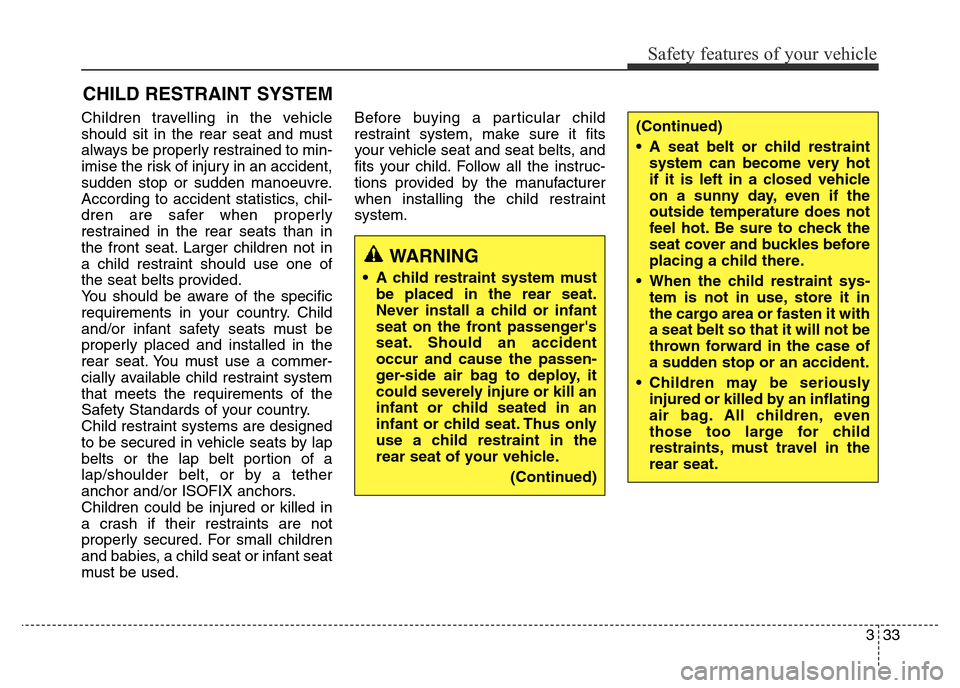
333
Safety features of your vehicle
Children travelling in the vehicle
should sit in the rear seat and must
always be properly restrained to min-
imise the risk of injury in an accident,
sudden stop or sudden manoeuvre.
According to accident statistics, chil-
dren are safer when properly
restrained in the rear seats than in
the front seat. Larger children not in
a child restraint should use one of
the seat belts provided.
You should be aware of the specific
requirements in your country. Child
and/or infant safety seats must be
properly placed and installed in the
rear seat. You must use a commer-
cially available child restraint system
that meets the requirements of the
Safety Standards of your country.
Child restraint systems are designed
to be secured in vehicle seats by lap
belts or the lap belt portion of a
lap/shoulder belt, or by a tether
anchor and/or ISOFIX anchors.
Children could be injured or killed in
a crash if their restraints are not
properly secured. For small children
and babies, a child seat or infant seat
must be used.Before buying a particular child
restraint system, make sure it fits
your vehicle seat and seat belts, and
fits your child. Follow all the instruc-
tions provided by the manufacturer
when installing the child restraint
system.
CHILD RESTRAINT SYSTEM
WARNING
• A child restraint system must
be placed in the rear seat.
Never install a child or infant
seat on the front passenger's
seat. Should an accident
occur and cause the passen-
ger-side air bag to deploy, it
could severely injure or kill an
infant or child seated in an
infant or child seat. Thus only
use a child restraint in the
rear seat of your vehicle.
(Continued)
(Continued)
• A seat belt or child restraint
system can become very hot
if it is left in a closed vehicle
on a sunny day, even if the
outside temperature does not
feel hot. Be sure to check the
seat cover and buckles before
placing a child there.
• When the child restraint sys-
tem is not in use, store it in
the cargo area or fasten it with
a seat belt so that it will not be
thrown forward in the case of
a sudden stop or an accident.
• Children may be seriously
injured or killed by an inflating
air bag. All children, even
those too large for child
restraints, must travel in the
rear seat.
Page 52 of 498
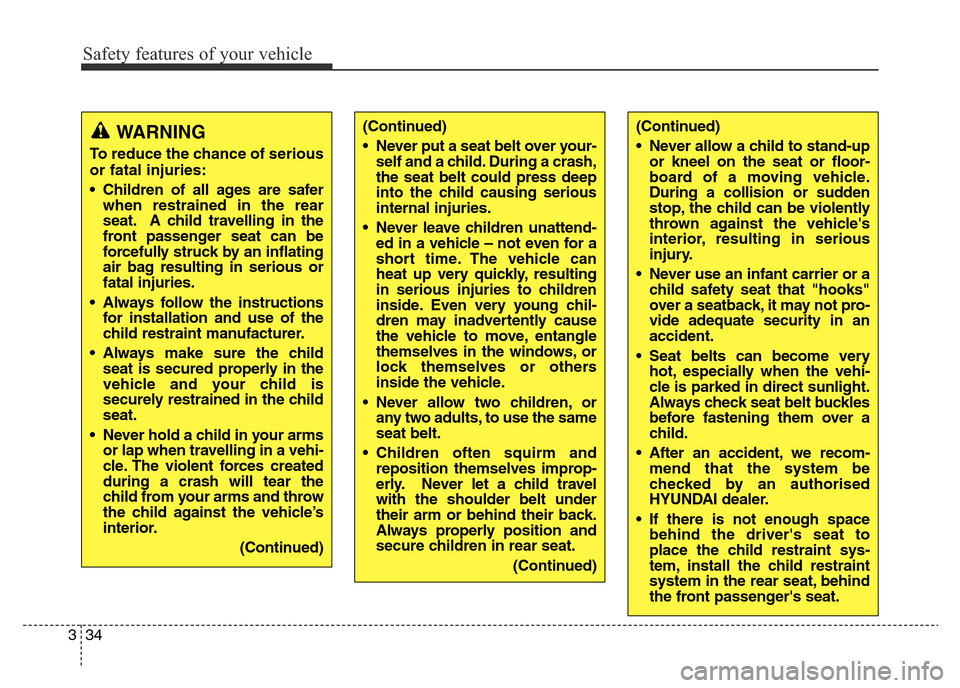
Safety features of your vehicle
34 3
(Continued)
• Never put a seat belt over your-
self and a child. During a crash,
the seat belt could press deep
into the child causing serious
internal injuries.
• Never leave children unattend-
ed in a vehicle – not even for a
short time. The vehicle can
heat up very quickly, resulting
in serious injuries to children
inside. Even very young chil-
dren may inadvertently cause
the vehicle to move, entangle
themselves in the windows, or
lock themselves or others
inside the vehicle.
• Never allow two children, or
any two adults, to use the same
seat belt.
• Children often squirm and
reposition themselves improp-
erly. Never let a child travel
with the shoulder belt under
their arm or behind their back.
Always properly position and
secure children in rear seat.
(Continued)(Continued)
• Never allow a child to stand-up
or kneel on the seat or floor-
board of a moving vehicle.
During a collision or sudden
stop, the child can be violently
thrown against the vehicle's
interior, resulting in serious
injury.
• Never use an infant carrier or a
child safety seat that "hooks"
over a seatback, it may not pro-
vide adequate security in an
accident.
• Seat belts can become very
hot, especially when the vehi-
cle is parked in direct sunlight.
Always check seat belt buckles
before fastening them over a
child.
• After an accident, we recom-
mend that the system be
checked by an authorised
HYUNDAI dealer.
• If there is not enough space
behind the driver's seat to
place the child restraint sys-
tem, install the child restraint
system in the rear seat, behind
the front passenger's seat.WARNING
To reduce the chance of serious
or fatal injuries:
• Children of all ages are safer
when restrained in the rear
seat. A child travelling in the
front passenger seat can be
forcefully struck by an inflating
air bag resulting in serious or
fatal injuries.
• Always follow the instructions
for installation and use of the
child restraint manufacturer.
• Always make sure the child
seat is secured properly in the
vehicle and your child is
securely restrained in the child
seat.
• Never hold a child in your arms
or lap when travelling in a vehi-
cle. The violent forces created
during a crash will tear the
child from your arms and throw
the child against the vehicle’s
interior.
(Continued)
Page 54 of 498
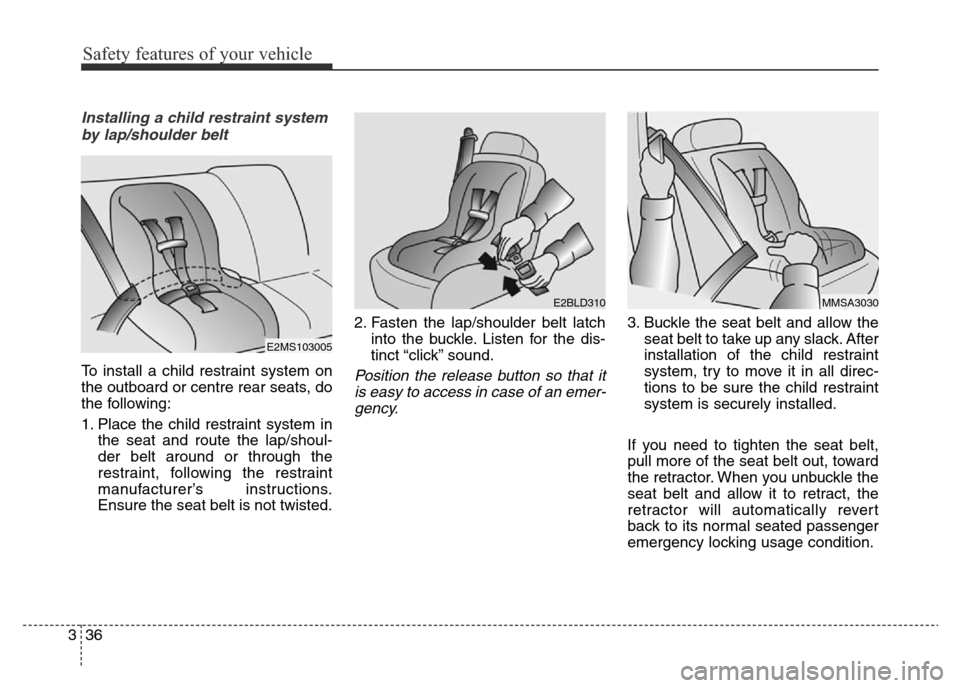
Safety features of your vehicle
36 3
Installing a child restraint system
by lap/shoulder belt
To install a child restraint system on
the outboard or centre rear seats, do
the following:
1. Place the child restraint system in
the seat and route the lap/shoul-
der belt around or through the
restraint, following the restraint
manufacturer’s instructions.
Ensure the seat belt is not twisted.2. Fasten the lap/shoulder belt latch
into the buckle. Listen for the dis-
tinct “click” sound.Position the release button so that it
is easy to access in case of an emer-
gency.
3. Buckle the seat belt and allow the
seat belt to take up any slack. After
installation of the child restraint
system, try to move it in all direc-
tions to be sure the child restraint
system is securely installed.
If you need to tighten the seat belt,
pull more of the seat belt out, toward
the retractor. When you unbuckle the
seat belt and allow it to retract, the
retractor will automatically revert
back to its normal seated passenger
emergency locking usage condition.
MMSA3030E2BLD310
E2MS103005